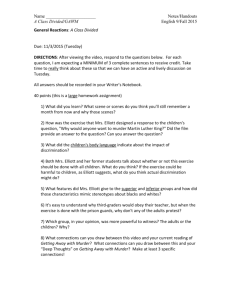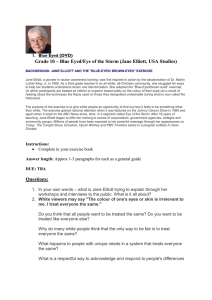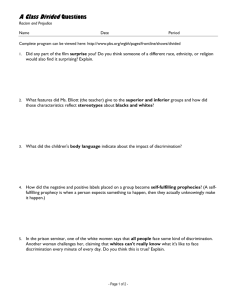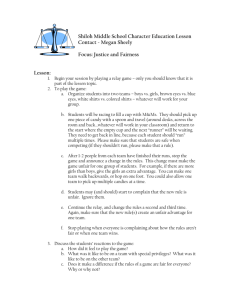Jane Elliot
advertisement
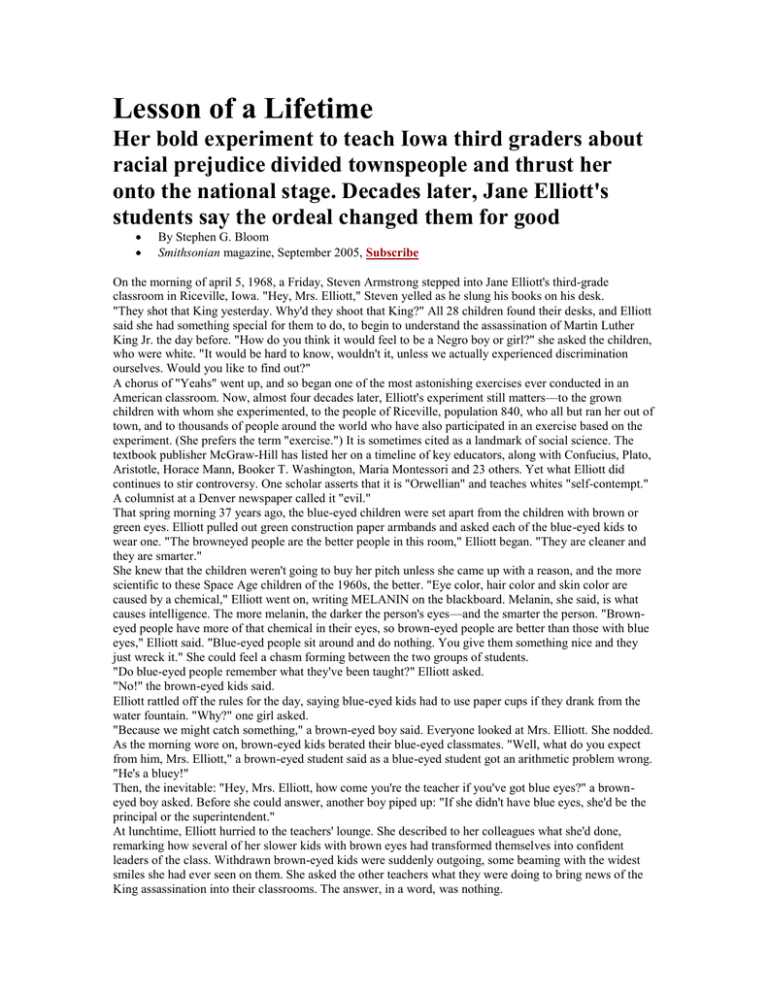
Lesson of a Lifetime Her bold experiment to teach Iowa third graders about racial prejudice divided townspeople and thrust her onto the national stage. Decades later, Jane Elliott's students say the ordeal changed them for good By Stephen G. Bloom Smithsonian magazine, September 2005, Subscribe On the morning of april 5, 1968, a Friday, Steven Armstrong stepped into Jane Elliott's third-grade classroom in Riceville, Iowa. "Hey, Mrs. Elliott," Steven yelled as he slung his books on his desk. "They shot that King yesterday. Why'd they shoot that King?" All 28 children found their desks, and Elliott said she had something special for them to do, to begin to understand the assassination of Martin Luther King Jr. the day before. "How do you think it would feel to be a Negro boy or girl?" she asked the children, who were white. "It would be hard to know, wouldn't it, unless we actually experienced discrimination ourselves. Would you like to find out?" A chorus of "Yeahs" went up, and so began one of the most astonishing exercises ever conducted in an American classroom. Now, almost four decades later, Elliott's experiment still matters—to the grown children with whom she experimented, to the people of Riceville, population 840, who all but ran her out of town, and to thousands of people around the world who have also participated in an exercise based on the experiment. (She prefers the term "exercise.") It is sometimes cited as a landmark of social science. The textbook publisher McGraw-Hill has listed her on a timeline of key educators, along with Confucius, Plato, Aristotle, Horace Mann, Booker T. Washington, Maria Montessori and 23 others. Yet what Elliott did continues to stir controversy. One scholar asserts that it is "Orwellian" and teaches whites "self-contempt." A columnist at a Denver newspaper called it "evil." That spring morning 37 years ago, the blue-eyed children were set apart from the children with brown or green eyes. Elliott pulled out green construction paper armbands and asked each of the blue-eyed kids to wear one. "The browneyed people are the better people in this room," Elliott began. "They are cleaner and they are smarter." She knew that the children weren't going to buy her pitch unless she came up with a reason, and the more scientific to these Space Age children of the 1960s, the better. "Eye color, hair color and skin color are caused by a chemical," Elliott went on, writing MELANIN on the blackboard. Melanin, she said, is what causes intelligence. The more melanin, the darker the person's eyes—and the smarter the person. "Browneyed people have more of that chemical in their eyes, so brown-eyed people are better than those with blue eyes," Elliott said. "Blue-eyed people sit around and do nothing. You give them something nice and they just wreck it." She could feel a chasm forming between the two groups of students. "Do blue-eyed people remember what they've been taught?" Elliott asked. "No!" the brown-eyed kids said. Elliott rattled off the rules for the day, saying blue-eyed kids had to use paper cups if they drank from the water fountain. "Why?" one girl asked. "Because we might catch something," a brown-eyed boy said. Everyone looked at Mrs. Elliott. She nodded. As the morning wore on, brown-eyed kids berated their blue-eyed classmates. "Well, what do you expect from him, Mrs. Elliott," a brown-eyed student said as a blue-eyed student got an arithmetic problem wrong. "He's a bluey!" Then, the inevitable: "Hey, Mrs. Elliott, how come you're the teacher if you've got blue eyes?" a browneyed boy asked. Before she could answer, another boy piped up: "If she didn't have blue eyes, she'd be the principal or the superintendent." At lunchtime, Elliott hurried to the teachers' lounge. She described to her colleagues what she'd done, remarking how several of her slower kids with brown eyes had transformed themselves into confident leaders of the class. Withdrawn brown-eyed kids were suddenly outgoing, some beaming with the widest smiles she had ever seen on them. She asked the other teachers what they were doing to bring news of the King assassination into their classrooms. The answer, in a word, was nothing. Back in the classroom, Elliott's experiment had taken on a life of its own. A smart blue-eyed girl who had never had problems with multiplication tables started making mistakes. She slumped. At recess, three brown-eyed girls ganged up on her. "You better apologize to us for getting in our way because we're better than you are," one of the brownies said. The blue-eyed girl apologized. On Monday, Elliott reversed the exercise, and the brown-eyed kids were told how shifty, dumb and lazy theywere. Later, it would occur to Elliott that the blueys were much less nasty than the brown-eyed kids had been, perhaps because the blue-eyed kids had felt the sting of being ostracized and didn't want to inflict it on their former tormentors. When the exercise ended, some of the kids hugged, some cried. Elliott reminded them that the reason for the lesson was the King assassination, and she asked them to write down what they had learned. Typical of their responses was that of Debbie Hughes, who reported that "the people in Mrs. Elliott's room who had brown eyes got to discriminate against the people who had blue eyes. I have brown eyes. I felt like hitting them if I wanted to. I got to have five minutes extra of recess." The next day when the tables were turned, "I felt like quitting school. . . . I felt mad. That's what it feels like when you're discriminated against." Elliott shared the essays with her mother, who showed them to the editor of the weekly Riceville Recorder. He printed them under the headline "How Discrimination Feels." The Associated Press followed up, quoting Elliott as saying she was "dumbfounded" by the exercise's effectiveness. "I think these children walked in a colored child's moccasins for a day," she was quoted as saying. That might have been the end of it, but a month later, Elliott says, Johnny Carson called her. "Would you like to come on the show?" he asked. Elliott flew to the NBC studio in New York City. On the "Tonight Show" Carson broke the ice by spoofing Elliott's rural roots. "I understand this is the first time you've flown?" Carson asked, grinning. "On an airplane, it is," Elliott said to appreciative laughter from the studio audience. She chatted about the experiment, and before she knew it was whisked off the stage. Hundreds of viewers wrote letters saying Elliott's work appalled them. "How dare you try this cruel experiment out on white children," one said. "Black children grow up accustomed to such behavior, but white children, there's no way they could possibly understand it. It's cruel to white children and will cause them great psychological damage." Elliott replied, "Why are we so worried about the fragile egos of white children who experience a couple of hours of made-up racism one day when blacks experience real racism every day of their lives?" The people of riceville did not exactly welcome Elliott home from New York with a hayride. Looking back, I think part of the problem was that, like the residents of other small midwestern towns I've covered, many in Riceville felt that calling attention to oneself was poor manners, and that Elliott had shone a bright light not just on herself but on Riceville; people all over the United States would think Riceville was full of bigots. Some residents were furious. When Elliott walked into the teachers' lounge the next Monday, several teachers got up and walked out. When she went downtown to do errands, she heard whispers. She and her husband, Darald Elliott, then a grocer, have four children, and they, too, felt a backlash. Their 12-year-old daughter, Mary, came home from school one day in tears, sobbing that her sixth-grade classmates had surrounded her in the school hallway and taunted her by saying her mother would soon be sleeping with black men. Brian, the Elliotts' oldest son, got beaten up at school, and Jane called the ringleader's mother. "Your son got what he deserved," the woman said. When Sarah, the Elliotts' oldest daughter, went to the girls' bathroom in junior high, she came out of a stall to see a message scrawled in red lipstick on the mirror: "Nigger lover." Elliott is nothing if not stubborn. She would conduct the exercise for the nine more years she taught the third grade, and the next eight years she taught seventh and eighth graders before giving up teaching in Riceville, in 1985, largely to conduct the eye-color exercise for groups outside the school. In 1970, she demonstrated it for educators at a White House Conference on Children and Youth. ABC broadcast a documentary about her work. She has led training sessions at General Electric, Exxon, AT&T, IBM and other corporations, and has lectured to the IRS, the U.S. Navy, the U.S. Department of Education and the Postal Service. She has spoken at more than 350 colleges and universities. She has appeared on the "Oprah Winfrey Show" five times. The fourth of five children, Elliott was born on her family's farm in Riceville in 1933, and was delivered by her Irish-American father himself. She was 10 before the farmhouse had running water and electricity. She attended a oneroom rural schoolhouse.Today, at 72, Elliott, who has short white hair, a penetrating gaze and no-nonsense demeanor, shows no signs of slowing. She and Darald split their time between a converted schoolhouse in Osage, Iowa, a town 18 miles from Riceville, and a home near Riverside, California. Elliott's friends and family say she's tenacious, and has always had a reformer's zeal. "She was an excellent school teacher, but she has a way about her," says 90-year-old Riceville native Patricia Bodenham, who has known Elliott since Jane was a baby. "She stirs people up." Vision and tenacity may get results, but they don't always endear a person to her neighbors. "Mention two words—Jane Elliott—and you get a flood of emotions from people," says Jim Cross, the Riceville Recorder's editor these days. "You can see the look on their faces. It brings up immediate anger and hatred." When I met Elliott in 2003, she hadn't been back to Riceville in 12 years. We walked into the principal's office at RicevilleElementary School, Elliott's old haunt. The secretary on duty looked up, startled, as if she had just seen a ghost. "We want to see Room No. 10," Elliott said. It was typical of Elliott's blunt style—no "Good morning," no small talk. The secretary said the south side of the building was closed, something about waxing the hallways. "We just want to peek in," I volunteered. "We'll just be a couple of minutes." Absolutely not. "This here is Jane Elliott," I said. "She taught in this school for 18 years." "I know who she is." We backed out. I was stunned. Elliott was not. "They can't forget me," she said, "and because of who they are, they can't forgive me." We stopped on Woodlawn Avenue, and a woman in her mid-40s approached us on the sidewalk. "That you, Ms. Elliott?" Jane shielded her eyes from the morning sun. "Malinda? Malinda Whisenhunt?" "Ms. Elliott, how are you?" The two hugged, and Whisenhunt had tears streaming down her cheeks. Now 45, she had been in Elliott's third grade class in 1969. "Let me look at you," Elliott said. "You know, sweetheart, you haven't changed one bit. You've still got that same sweet smile. And you'll always have it." "I've never forgotten the exercise," Whisenhunt volunteered. "It changed my life. Not a day goes by without me thinking about it, Ms. Elliott. When my grandchildren are old enough, I'd give anything if you'd try the exercise out on them. Would you? Could you?" Tears formed in the corners of Elliott's eyes. The corn grows so fast in northern Iowa—from seedling to seven-foot-high stalk in 12 weeks—that it crackles. In the early morning, dew and fog cover the acres of gently swaying stalks that surround Riceville the way water surrounds an island. The tallest structure in Riceville is the water tower. The nearest traffic light is 20 miles away. The Hangout Bar & Grill, the Riceville Pharmacy and ATouch of Dutch, a restaurant owned by Mennonites, line Main Street. In a grassy front yard down the block is a hand-lettered sign: "Glads for Sale, 3 for $1." Folks leave their cars unlocked, keys in the ignition. Locals say that drivers don't signal when they turn because everyone knows where everyone else is going. Most Riceville residents seem to have an opinion of Elliott, whether or not they've met her. "It's the same thing over and over again," Cross says. "It's Riceville 30 years ago. Some people feel we can't move on when you have her out there hawking her 30-year-old experiment. It's the Jane Elliott machine." Walt Gabelmann, 83, was Riceville's mayor for 18 years beginning in 1966. "She could get kids to do anything she wanted them to," he says of Elliott. "She got carried away by this possession she developed over human beings." A former teacher, Ruth Setka, 79, said she was perhaps the only teacher who would still talk to Elliott. "I think third grade was too young for what she did. Junior high, maybe. Little children don't like uproar in the classroom. And what she did caused an uproar. Everyone's tired of her. I'm tired of hearing about her and her experiment and how everyone here is a racist. That's not true. Let's just move on." Steve Harnack, 62, served as the elementary school principal beginning in 1977. "I don't think this community was ready for what she did," he said. "Maybe the way to sell the exercise would have been to invite the parents in, to talk about what she'd be doing. You must get the parents first." Dean Weaver, 70, superintendent of Riceville schools from 1972 to 1979, said, "She'd just go ahead and do things. She was a local girl and the other teachers were intimidated by her success. Jane would get invited to go to Timbuktu to give a speech. That got the other teachers angry." For years scholars have evaluated Elliott's exercise, seeking to determine if it reduces racial prejudice in participants or poses a psychological risk to them. The results are mixed. Two education professors in England, Ivor F. Goodson and Pat Sikes, suggest that Elliott's experiment was unethical because the participants weren't informed of its real purpose beforehand. Alan Charles Kors, a professor of history at the University of Pennsylvania, says Elliott's diversity training is "Orwellian" and singled her out as "the Torquemada of thought reform." Kors writes that Elliott's exercise taught "blood-guilt and self-contempt to whites," adding that "in her view, nothing has changed in America since the collapse of Reconstruction." In a similar vein, Linda Seebach, a conservative columnist for the Rocky Mountain News, wrote in 2004 that Elliott was a "disgrace" and described her exercise as "sadistic," adding, "You would think that any normal person would realize that she had done an evil thing. But not Elliott. She repeated the abuse with subsequent classes, and finally turned it into a fully commercial enterprise." Others have praised Elliott's exercise. In Building Moral Intelligence: The Seven Essential Virtues That Teach Kids to Do the Right Things, educational psychologist Michele Borda says it "teaches our children to counter stereotypes before they become full-fledged, lasting prejudices and to recognize that every human being has the right to be treated with respect." Amitai Etzioni, a sociologist at George WashingtonUniversity, says the exercise helps develop character and empathy. And StanfordUniversity psychologist Philip G. Zimbardo writes in his 1979 textbook, Psychology and Life, that Elliott's "remarkable" experiment tried to show "how easily prejudiced attitudes may be formed and how arbitrary and illogical they can be." Zimbardo—creator of the also controversial 1971 Stanford Prisoner Experiment, which was stopped after college student volunteers acting as "guards" humiliated students acting as "prisoners"—says Elliott's exercise is "more compelling than many done by professional psychologists." Elliott defends her work as a mother defends her child. "You have to put the exercise in the context of the rest of the year. Yes, that day was tough. Yes, the children felt angry, hurt, betrayed. But they returned to a better place—unlike a child of color, who gets abused every day, and never has the ability to find him or herself in a nurturing classroom environment." As for the criticism that the exercise encourages children to distrust authority figures—the teacher lies, then recants the lies and maintains they were justified because of a greater good—she says she worked hard to rebuild her students' trust. The exercise is "an inoculation against racism," she says. "We give our children shots to inoculate them against polio and smallpox, to protect them against the realities in the future. There are risks to those inoculations, too, but we determine that those risks are worth taking." Elliott says the role of a teacher is to enhance students' moral development. "That's what I tried to teach, and that's what drove the other teachers crazy. School ought to be about developing character, but most teachers won't touch that with a ten-foot pole." Elliott and I were sitting at her dining room table. The smell of the crops and loam and topsoil and manure wafted though the open door. Outside, rows of corn stretched to the horizon. "There's a sense of renewal here that I've never seen anywhere else," Elliott says. It occurs to me that for a teacher, the arrival of new students at the start of each school year has a lot in common with the return of crops each summer. Elliott continues, "Just when you think that the fertile soil can sprout no more, another season comes round, and you see another year of bountiful crops, tall and straight. It makes you proud."
